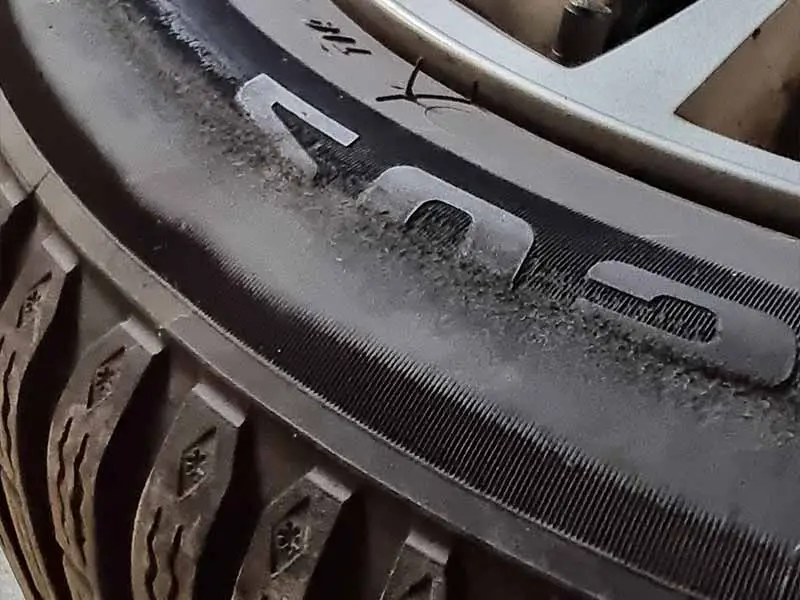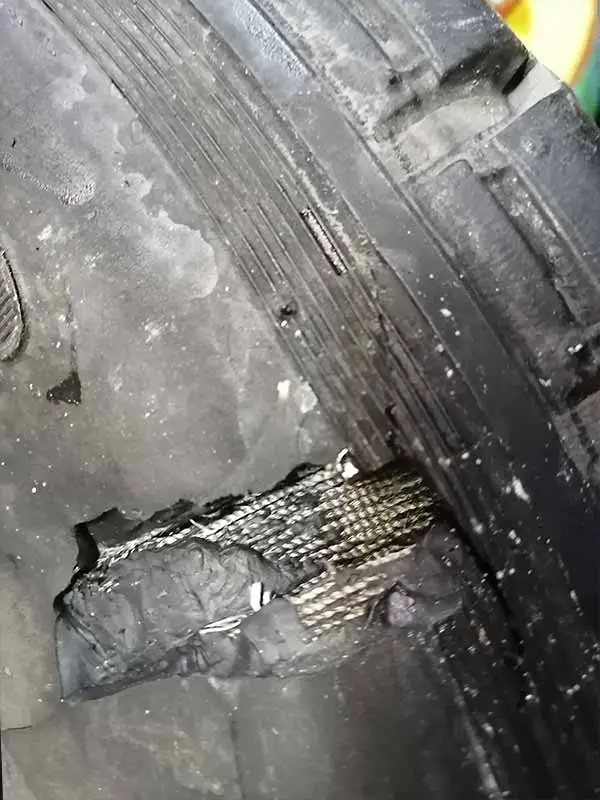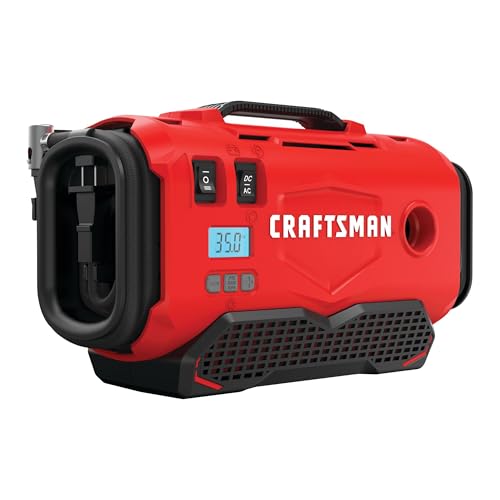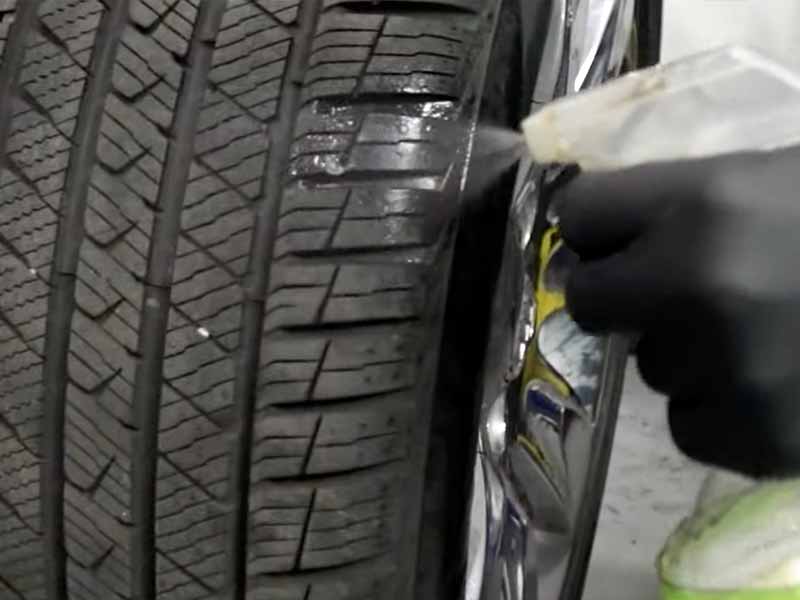Did you know that around 738 tire-related accidents happen every day in the US? That’s a pretty startling statistic, right? You’ve probably experienced that sinking feeling when your car’s low tire pressure warning light comes on, leaving you wondering if you have a flat tire or if it just needs a little air.
How To Tell If A Tire Is Flat Or Just Needs Air
- First, check the tire’s pressure using an air pressure gauge.
- If the pressure is significantly lower than the recommended PSI:
- Inflate the tire.
- Monitor it for any air leaks or a drop in pressure over time.
- A puncture or damage may indicate that the tire will go flat.
In this article, we’ll guide you through the process of determining the issue and taking the right action, so you can hit the road with confidence.
Let’s take a closer look.

Flat Tire Vs Low Tire Pressure
A flat tire can be due to a cut or puncture, or it could simply be the normal drop in pressure over time or due to temperature changes. It’s super important to know whether your tire has a puncture or simply needs some air, especially when you’re on the road. Let’s dive into the differences between the two.
A punctured or flat tire is one that has a hole or a cut, usually caused by a sharp object like a nail or glass. When this happens, air escapes from the tire, and it can’t hold its shape properly. A tire with a puncture can cause problems for your car and can be dangerous if you keep driving on it. It might lead to poor handling, decreased fuel efficiency, or even a blowout.
On the other hand, a tire that needs air might not have any damage. Tires naturally lose some air over time, which is completely normal. In fact, experts say that tires can lose about 1 to 2 pounds per square inch (PSI) of pressure each month. Also, as the weather changes, so does the air pressure inside your tires. You may have noticed that your tire pressure warning light comes on when it’s cold outside. That’s because the air inside your tires contracts, or gets smaller, in colder temperatures, causing the pressure to drop. When the weather gets warmer, the air expands, or gets bigger, and the pressure goes up.
So, if you have a tire that’s low on air, it might not be punctured at all. It could just be a result of the natural air leakage or changes in temperature. It’s important to check your tire pressure regularly to make sure your tires are in good shape and ready for the road. That way, you can avoid unnecessary trips to the repair shop and keep your car running smoothly and safely.
What To Do When The TPMS Light Comes On
The Tire Pressure Monitoring System (TPMS) light on your dashboard is designed to alert you when the air pressure in one or more of your tires has dropped below 75% of the manufacturer’s recommended level. When the tire warning light comes on, it’s a signal that you need to take action. It doesn’t necessarily mean tire is flat, but it does mean that there is a chance you have a flat tire and you should take this warning seriously.

Here’s what to do when your TPMS light comes on:
- Don’t Panic: A TPMS light doesn’t necessarily mean you have a flat tire. It could simply be that your tire pressure is low due to natural air loss or changes in temperature. However, it’s important to address the issue as soon as possible.
- Find A Safe Place To Pull Over: If you’re driving when the TPMS light comes on, find a safe spot to pull over as soon as you can. It’s not advisable to keep driving with a flat tire or low tire pressure, as it can affect your car’s handling and fuel efficiency, and may even lead to a blowout.
- Check Your Tire Pressure: Use a tire pressure gauge to measure the pressure in all of your tires, including the spare. Compare the readings to the recommended pressures listed in your owner’s manual or on the sticker inside the driver’s door.
- Inflate Your Tires If Needed: If the pressure is lower than the recommended level, inflate your tires using a portable air compressor or a gas station air pump.
- Inspect For Punctures Or Damage: If your tire pressure is significantly lower than the recommended level, or if you notice that one tire is much lower than the others, it could be a sign of a puncture or damage that may have caused a flat tire. Check your tire for any visible issues, such as nails, cuts, or bulges. If you find any signs of damage, have your tire repaired or replaced as needed.
- Monitor Your Tire Pressure: After inflating your tires, keep an eye on the pressure for the next few days. If the pressure drops again, it could be a sign of a slow leak, and you’ll need to address the issue.
How to Visually Inspect Your Tires
Being able to inspect your tires by yourself is a super useful skill to have. It can save you time and help you figure out if you need to take action right away. So, let’s go over some steps to visually check your tires like a pro!

- Park Your Car On A Flat Surface: Make sure your car is parked on a level surface and turned off. This helps you get a better look at your tires and makes it safer to inspect them.
- Check For Obvious Signs Of Damage Or Wear: Start by walking around your car and taking a good look at each tire. Keep an eye out for any bulges, cracks, or cuts on the sidewalls or tread. These could be signs of damage that need to be addressed.
- Look For Punctures Or Cuts In The Tire: Punctures are often caused by sharp objects like nails or glass. If you see any foreign objects sticking out of your tire or any small cuts, it could mean your tire is punctured. It’s a good idea to remove the object carefully and examine the area to see if air is leaking.
- Examine The Tread: The tread is the pattern of grooves on the surface of your tire. It helps your car grip the road and stay safe in different driving conditions. If the tread looks worn down or uneven, it could be a sign that your tire needs to be replaced. One easy way to check tread depth is by using the penny test. Insert a penny into the tread with Lincoln’s head facing down. If you can see the top of his head, it’s time to think about getting new tires.
- Overall Visual Inspection: Finally, take a step back and look at the overall shape and appearance of your tire. If it looks flat or sagging, it might be low on air or have a puncture. If the tire appears to be in good shape, it might just need some air to bring it back to the recommended pressure.
The Importance Of A Portable Air Compressor
Having a portable air compressor on hand is a super smart move for any car owner. It can help you in emergencies and save you from having to find a reliable gas station air pump. If you ever have a flat tire or even just low tire pressure, it can turn an unexpected hassle into a minor inconvenience.

Let’s talk about why a portable air compressor is so important and how it can make your life easier!
- Unreliability Of Gas Station Air Pumps: Sometimes, gas station air pumps are out of order, or they might not give an accurate pressure reading. Plus, they can be expensive to use. With a portable air compressor, you don’t have to worry about finding a working air pump when you need one.
- Benefits Of Having A Portable Air Compressor: A portable air compressor is a small, easy-to-use device that you can keep in your trunk. It comes in super handy when you need to add air to your tires, whether you’re at home, on a road trip, or in an emergency situation. Attempting to drive on an underinflated or flat tire, even for a short distance, is dangerous and will quickly ruin the tire.
- Ensuring Safe Driving Conditions In Case Of Emergencies: If the pressure is low in one of your tires or you have a slow leak, it can be dangerous to drive to the nearest gas station to inflate it. With a portable air compressor, you can add air to your tire right away without having to drive on an underinflated tire. This keeps you safer on the road and helps prevent damage to your tire or car.
- Easy To Use And Maintain: Portable air compressors are user-friendly and don’t require a lot of maintenance. You just need to plug it into your car’s 12-volt outlet or attach it to your car’s battery, connect the hose to your tire’s valve stem, and turn it on. The compressor will start inflating your tire, and many models have a built-in pressure gauge, so you can easily monitor the pressure as you go.
How To Properly Inflate A Tire
If you’ve checked your tire pressure and found that one (or more) of your tires needs air, don’t worry! Inflating a tire is super easy, and we’re going to show you how to do it like a pro. Just follow these steps, and you’ll be back on the road in no time.

- Locating The Recommended Air Pressure: Before you start, you need to know the recommended pressure for your tires. You can find this information in your owner’s manual or on a sticker inside the driver’s door. The pressure is usually listed in pounds per square inch (PSI).
- Get Your Air Compressor Ready: If you have a portable air compressor, make sure it’s charged or plugged into your car’s 12-volt outlet. If you’re using a gas station air pump, insert the required coins and start the pump.
- Remove The Valve Cap: Unscrew the valve cap from your tire’s valve stem and set it aside. Make sure the valve stem is clean and free of dirt or debris.
- Attach The Air Hose: Connect the air hose from the compressor or pump to the valve stem. Press down firmly to ensure a good seal, and make sure the hose is straight and not at an angle.
- Inflate The Tire: Turn on the portable air compressor or start filling with the gas station air pump. Keep an eye on the pressure gauge (if your compressor has one) or use your tire pressure gauge to check the pressure as you fill the tire.
- Check The Air Pressure: As you’re inflating your tire, occasionally stop and check the pressure using your tire pressure gauge. Remember to press the gauge down firmly on the valve stem for an accurate reading.
- Stop When The Tire Reaches The Recommended Pressure: Once your tire is inflated to the recommended pressure, turn off the portable air compressor or stop filling at the gas station pump. It’s important not to overinflate your tire, as this can cause damage and affect your car’s handling.
- Replace The Valve Cap: After your tire is properly inflated, put the valve cap back on and make sure it’s tight. This keeps dirt and dust from getting into the valve stem.
How To Know If Your Tire Is Holding Air
After inflating a tire that needed air, it’s important to make sure it’s holding air properly and you won’t find yourself with a flat tire again. This can help you determine if there’s a puncture or some other type of damage that might lead to a flat tire. Here’s how you can check if your tire is holding air after inflating:

- Listen For Air Leaks: After inflating your tire, stand close to it and listen carefully for any hissing sounds. If you hear air leaking, it might be coming from a puncture or a damaged valve stem. You’ll need to locate the source of the leak and address the issue.
- Use The “Soap Bubble Test”: Mix a small amount of dish soap with water in a spray bottle or a bowl. Spray or apply the soapy solution to your tire, especially around the valve stem and any areas where you suspect a leak. If there’s a leak, you’ll see bubbles forming at the source. This can help you pinpoint the location of the problem.
- Monitor Tire Pressure: Keep an eye on your tire pressures for the next few days after inflating. You can use your air pressure gauge to check the pressure each day to see if it’s dropping. If the pressure drops significantly, it’s a sign that your tire isn’t holding air properly and might have a puncture or other damage.
- Visually Inspect Your Tire After Driving: After you’ve driven your car for a bit, take a look at your tire again. If it appears to be sagging or flat, it might not be holding air well. In this case, you’ll need to address the issue before it causes more problems.
Resources
Below are some links you may find helpful when learning about tires
Final Thoughts
Understanding the difference between a completely flat tire and one that just needs air is vital for your safety and maintaining your car’s performance. By following the steps we discussed, you can easily identify tire issues and act accordingly, preventing potential accidents or costly repairs. Remember, regular tire maintenance is essential for a smooth and worry-free ride.
Good luck and happy motoring.




